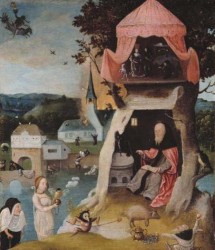
Koldeweij 1988
“Nogmaals de ‘St. Antonius-kwelling’ van de hand van een navolger van Jeroen Bosch’ (A.M. Koldeweij) 1988
[in: Antiek, vol. 22, nr. 8 (March 1988), pp. 443-448]
The suggestion that the little panel with a Temptation of St. Anthony (Utrecht, Centraal Museum) once belonged to a monastery in Utrecht (see De Meyere 1986) is only based on a rather vague tradition. In fact it is not clear whether the little panel originates from a religious environment (church, monastery, beguinage) or from a more profane one (house of a commoner, hospital) [p. 443]. On stylistic grounds the Utrecht panel can be dated late in the first quarter or towards the middle of the sixteenth century [p. 443].
The Staatsgalerie in Stuttgart has a panel (inventory number 2285) with an almost identical St. Anthony scene. It is also unsigned and undated. Both panels can probably be traced back to the same source [p. 443]. The Utrecht panel is smaller and painted with less skill, the composition was narrowed and to the left some details that can be seen in Stuttgart have disappeared [p. 445]. On the Stuttgart panel the background is complete and therefore easier to interpret [p. 445]. Unverfehrt (1980) thinks the Stuttgart panel orginates from Antwerp and was painted around 1530. The same is probably true for the Utrecht panel (which is not mentioned by Unverfehrt) [p. 448].
On the exact meaning of the St. Anthony depictions by Bosch and his followers the last word has not been spoken yet [pp. 447-448].
[explicit]